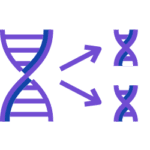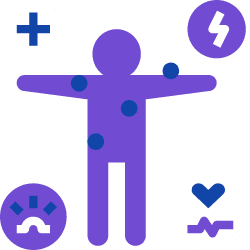What Is CHAMP1?
Find Out Below
What Is CHAMP1?
CHAMP1 is short for CHromosome Alignment-Maintaining Phosphoprotein 1
CHAMP1 is an ultra-rare genetic neurodevelopmental disorder caused by a mutation in the CHAMP1 gene, part of chromosome 13.
CHAMP1 disorders causes a reduction in the level of correctly functioning CHAMP1 protein.
What Does CHAMP1 Do?
The CHAMP1 gene is important for cell division (mitosis), brain development, DNA breakdown & repair, and early embryonic development.
When impaired, it causes cognitive problems, physical disabilities and medical complexities.
How Rare Is CHAMP1?
CHAMP1 affects roughly 1 in every 41 million people.
As of 2024 there are around 200 documented CHAMP1 diagnoses worldwide.
As Whole Exome Sequencing and similar methodology are becoming more available the number of patients is expected to increase dramatically.
What causes CHAMP1?
Sometimes biology doesn’t stick to the “blueprint plan” and genetic mutations occur. A genetic mutation is a permanent change to a gene.
CHAMP1 is typically a “de novo” (non-inherited) mutation that occurs in one of the two copies of the CHAMP1 gene on Chromosome 13.
Patients express one healthy copy and one mutated copy or variant of the CHAMP1 gene.
There are multiple variants of the gene mutation which affect individuals differently along a spectrum of severity.
The mutations (or variants) that occur in the CHAMP1 gene include missense mutations, nonsense mutations, frameshift, duplication, microdeletions and deletions.
What Does My CHAMP1 Variant Mean?
The type of mutation will determine how the CHAMP1 protein is altered.
Different mutations can cause a reduction in the amount of functioning CHAMP1 protein, as well as a change to, loss of, or gain of protein function.
In the alphabet different letters can be combined to produce useful and meaningful words – but only if the letters are put together in the “correct” way.
The same goes for DNA. These letters are called nucleotides and are effectively arranged and read as sentences containing multiple 3 letter words called Codons.
Let’s say the letters in a healthy CHAMP1 gene are arranged like this “THE CAT HAS RED FUR”
Codons are arranged in a specific manner to form a certain gene, which in turn, encodes a specific protein.
In someone with no change to their CHAMP1 gene, there are two identical fully functional CHAMP1 genes both producing the CHAMP1 protein.
See below for more information on each type of mutation.

Deletion Or Micro Deletion
Deletions results in the gene having a partially complete set of letters that are still divisible by 3.
“THE CAT HAS” or “THE RED FUR”
In a CHAMP with a deletion, there is 1 fully functional CHAMP1 gene and a CHAMP1 gene that is wholly missing (A Deletion) or partly missing (A Micro Deletion).
This results in the CHAMP having a functioning protein but only around 50% of someone with 2 healthy genes.
Deletion, if encompassing only the CHAMP1 gene typically presents the fewest and most mild symptoms.
Missense Mutations
Missense mutations results in the gene having a complete set of letters but with a spelling mistake that changes its meaning.
“THE CAT HAD RED FUR” or “THE BAT HAS RED FUR”
In a CHAMP with a Missense mutation, there is 1 fully functional CHAMP1 gene and 1 altered CHAMP1 gene.
The altered gene has a change to a single nucleotide, represented by letters in the above diagram.
The gene still produces a protein, but one that functions differently than it should.
Missense mutation symptoms tend to be mild when inherited and more severe when de novo.
Nonsense Mutations
Nonsense mutations results in the gene having a complete set of letters but with a full stop part way through, meaning anything after it is ignored.
“THE CAT .AS RED FUR” or “THE CAT HAS R.D FUR“
In a CHAMP with a Nonsense mutation, there is 1 fully functional CHAMP1 gene and 1 altered CHAMP1 gene.
The altered gene with the premature termination (stop codon) can result in a non-functioning, partially functioning or altered-functioning protein.
Nonsense mutation symptoms vary between mild to severe depending on the location of the mutation.
Frameshift
A Frameshift results in the gene having a partially complete set of letters that is no longer divisible by 3 causing the letters after to move up, completely changing the sentence after the missing letter or letters, for example removing the S from HAS results in:
“THE CAT HAR EDF UR” or “THE CAT HAS RFU R”
In a CHAMP with a Frameshift, there is 1 fully functional CHAMP1 gene and 1 altered CHAMP1 gene.
Frameshift mutation is caused by insertions or deletions of one or two nucleotides (letters) meaning the total is not divisible by three.
This can change the reading frame (the grouping of the codons) resulting in a completely different translation from the original.
This creates an altered protein, the earlier in the sequence the deletion or insertion occurs, the more altered the protein.
Frameshifts present some of the most severe symptoms.
Duplication
Duplication results in the gene having one or more extra sets of letters that are still divisible by 3. This means the sentence is longer and incorrect.
“THE CAT HAS RED HAS RED FUR” or “THE CAT HAS RED FUR FUR“
In a CHAMP with a Duplication, there is 1 fully functional CHAMP1 gene and 1 altered CHAMP1 gene.
A duplication is when a number of nucleotides are duplicated resulting in an altered gene that is both altered and longer than it should be. This creates an altered protein.
Duplications present some of the most severe symptoms.
What are the symptoms of CHAMP1?

Depending on the mutation type, CHAMP1 manifests differently along a spectrum of symptoms and severity.
In most cases, features of CHAMP1 appear early in life and can evolve with age.
Neurological Symptoms
• Epilepsy
• Seizures
• Movement disorders
• White matter and brain structural abnormalities
• Atypical neurological behaviour (i.e. stereotypy, anxiety, ADHD)
• Decreased sense of pain
• Difficulty falling or staying asleep
• Ataxia (impaired muscle control, coordination & movement)
Developmental Symptoms
•Autism spectrum disorders (ASD)
• Global developmental delays
• Gross motor delays or disabilities (i.e. difficulty or inability to sit or walk)
• Fine motor delays or disabilities (i.e. difficulty using hands purposefully)
• Speech and language delays, loss or disabilities
• Learning disabilities
• Challenges with daily living skills (i.e. dressing, self-feeding, toilet training)
Physical Symptoms
• Hypotonia (decreased muscle tone)
• Microcephaly (small head size)
• Plagiocephaly (flat head)
• Eye abnormalities (i.e. nystagmus, strabismus, hyperopia, myopia, amblyopia, coloboma)
• High occurrence of respiratory tract infections
• Gastroesophageal reflux (GERD)
• CVS (Cyclical Vomiting Syndrome)
• Incontinence
• Constipation
• Apnoea (narrowing airway during sleep)
• Ataxic or hypotonic gait (abnormal walking patterns)
• Flat nasal bridge
• Hearing abnormalities
• Low-set ears
• Epicanthic fold (skin fold of the upper eyelid covering the inner corner of the eye)
• Up-slanted palpebral fissures (outer corner of eye higher than inner corner)
• Eye hypertelorism (increased distance between eyes)
• Long face
• Prognathism (pointy chin)
• Short philtrum (shorter than normal distance between the upper lip and the nose)
• Constantly open mouth
• Tented upper lip vermilion (Triangular upper lip and mouth opening)
• Lip ptosis (drooping of the lower lip)
• High palate (unusually high and narrow roof of mouth)
• Dental issues (small or misaligned teeth, baby teeth stay in too long)
• Small Stature (height in the 3rd percentile or below)
• Hypermobility and hyperextensibility (joints have an increased range of motion)
• Hypoplastic nails (underdeveloped fingernails or toenails)
• Fifth finger clinodactyly (curved little fingers)
Is there a cure for CHAMP1?
Currently, there is no cure or significant treatment for CHAMP1.
The CHAMP1 Research Foundations have extensive genetic research underway.
Supportive therapies are available to help manage symptoms of CHAMP1.
Depending on symptoms, these can include medications, nutritional support, surgeries, developmental therapies, and assistive devices (including augmentative and alternative communication strategies).
CHAMP1 patient care teams may include experts from a variety of specialities, including neurology, epilepsy, genetics, gastroenterology, pulmonology, physiatry, ophthalmology or optometry, and various therapists (physical, occupational, vision, and speech therapists.)
What Is CHAMP1?
Find Out Below
What Is CHAMP1?
CHAMP1 is short for CHromosome Alignment-Maintaining Phosphoprotein 1
CHAMP1 is an ultra-rare genetic neurodevelopmental disorder caused by a mutation in the CHAMP1 gene, part of chromosome 13.
CHAMP1 disorders causes a reduction in the level of correctly functioning CHAMP1 protein.
What Does CHAMP1 Do?
The CHAMP1 gene is important for cell division (mitosis), brain development, DNA breakdown & repair, and early embryonic development.
When impaired, it causes cognitive problems, physical disabilities and medical complexities.
How Rare Is CHAMP1?
CHAMP1 affects roughly 1 in every 41 million people.
As of 2024 there are around 200 documented CHAMP1 diagnoses worldwide.
As Whole Exome Sequencing and similar methodology are becoming more available the number of patients is expected to increase dramatically.
What causes CHAMP1?
Sometimes biology doesn’t stick to the “blueprint plan” and genetic mutations occur. A genetic mutation is a permanent change to a gene.
CHAMP1 is typically a “de novo” (non-inherited) mutation that occurs in one of the two copies of the CHAMP1 gene on Chromosome 13.
Patients express one healthy copy and one mutated copy or variant of the CHAMP1 gene.
There are multiple variants of the gene mutation which affect individuals differently along a spectrum of severity.
The mutations (or variants) that occur in the CHAMP1 gene include missense mutations, nonsense mutations, frameshift, duplication, microdeletions and deletions.
What Does My CHAMP1 Variant Mean?
The type of mutation will determine how the CHAMP1 protein is altered.
Different mutations can cause a reduction in the amount of functioning CHAMP1 protein, as well as a change to, loss of, or gain of protein function.
In the alphabet different letters can be combined to produce useful and meaningful words – but only if the letters are put together in the “correct” way.
The same goes for DNA. These letters are called nucleotides and are effectively arranged and read as sentences containing multiple 3 letter words called Codons.
Let’s say the letters in a healthy CHAMP1 gene are arranged like this “THE CAT HAS RED FUR”
Codons are arranged in a specific manner to form a certain gene, which in turn, encodes a specific protein.
In someone with no change to their CHAMP1 gene, there are two identical fully functional CHAMP1 genes both producing the CHAMP1 protein.
See below for more information on each type of mutation.







